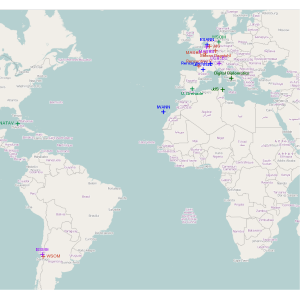Réaliser des cartes avec R et OpenStreetMapPlotting maps with R and OpenStreetMap
This tutorial is dedicated to Tibo who showed me how to use OpenStreetMap with R in the first place and gratefully sent me his script. The tutorial will explain first how to install the package OpenStreetMap under linux (which is actually a bit tricky) and will then explain how to use it to draw a map with the open online map OpenStreetMap through R.
Installing the package OpenStreetMap in R
I am using R version 3.0.1 (2013-05-16) — “Good Sport” on Ubuntu 12.04. The R version is thus not that of the ubuntu repository. To install the package OpenStreetMap, I proceeded as follows:
-
first, I installed a few additional ubuntu packages:
sudo apt-get install libproj-dev libgdal1-dev
-
then, I installed open jdk version 7:
sudo apt-get remove --purge openjdk-6-* sudo apt-get autoremove audo apt-get install openjdk-7-*
and updated R java configuration:
sudo R CMD javareconf
-
finally, I was able to install the R package
OpenStreetMapfrom Rinstall.packages("OpenStreetMap")(which requires the packages rJava and rgdal that had caused errors before I did the previously described configurations).</li> </ul>
Using
OpenStreetMapAs an example, I tried to produce a map where the last conferences I gave are located. To do so:
-
the first step is to download the map from OpenStreetMap (or another open map server). This is done by first finding the coordinates of the upper left corner and of the lower right corner on the map (on OpenStreetMap, you can use the “export” menu):
conf.map = openmap(c(60,-90),c(-45,45),type="osm")
-
the second step is to find the coordinates of the conference places. I give the example below for the year 2013 (Toulouse, Tenerife, Bruges, Lyon). To do so, you can once again use the “export” menu and then the following command lines in R
coord.conferences = rbind(c(-16.5,28.4),c(3.2,51.2),c(-70.6,-33.4),c(4.8,45.7))
-
then, the coordinates have to be properly converted into spatial points with proper Coordinate Reference System:
proj4string(coord.conferences) = CRS("+proj=longlat +ellps=WGS84") sp.conferences = spTransform(coord.conferences,CRS("+proj=merc +a=6378137 +b=6378137 +lat_ts=0.0+lon_0=0.0 +x_0=0.0 +y_0=0 +k=1.0 +units=m +nadgrids=@null +no_defs")) -
then the map and the points are plotted:
plot(conf.map,raster=TRUE) sapply(1:nrow(sp.conferences), function(ind) plot(xyb[ind,],add=TRUE,col="blue", lwd=2,pch=19)) -
and finally, the labels of the points are added:
sp.conferences.coord = coordinates(sp.conferences) conferences.names = c("IWANN","JdS, EGC","ESANN","Rencontres R") sapply(1:nrow(sp.conferences.coord), function(ind) text(sp.conferences.coord[ind,1],sp.conferences.coord[ind,2], conferences.names[ind],adj=1,pos=3,lwd=2,cex=0.7,col="blue"))
After having added a few more conferences/seminars, I finally obtained the following map:

Another example
The map of the main places for the Journées de Statistique de Toulouse:
has been made with the following command lines:
## Made by Thibault Laurent (for http://jd2013.sfds.asso.fr) # http://www.tse-fr.eu/index.php?option=com_wrapper&Itemid=398 require("OpenStreetMap") ## Select the bounding box of the map from the upper left corner to the lower # right corner ## Then select the type of map, from one of those: type.map=c("osm", "osm-bw", "maptoolkit-topo", "waze", "mapquest", "mapquest-aerial", "bing", "stamen-toner", "stamen-terrain", "stamen-watercolor", "osm-german", "osm-wanderreitkarte", "mapbox", "esri", "esri-topo", "nps", "apple-iphoto", "skobbler", "cloudmade-", "hillshade", "opencyclemap", "osm-transport", "osm-public-transport", "osm-bbike", "osm-bbike-german") map=openmap(c(43.611522,1.428533), c(43.598903,1.461059),type=type.map[1]) ## Locate the main places of the conference xy.1=c(1.431892,43.609747) xy.2=c(1.443877,43.604436) xy.3=c(1.455493,43.610231) xy.4=c(1.442447,43.600927) xy.5=c(1.440507,43.610111) xy.6=c(1.444758,43.604443) xy.7=c(1.449647,43.606678) # Create a spatial object and define the coordinate reference system xy=rbind(xy.1,xy.2,xy.3,xy.4,xy.5,xy.6,xy.7) xya=SpatialPoints(xy) proj4string(xya)=CRS("+proj=longlat +ellps=WGS84") xyb=spTransform(xya,CRS("+proj=merc +a=6378137 +b=6378137 +lat_ts=0.0 +lon_0=0.0 +x_0=0.0 +y_0=0 +k=1.0 +units=m +nadgrids=@null +no_defs")) ## Plot the map and the points plot(map,raster=TRUE) plot(xyb[1,],add=TRUE,col="darkred",lwd=4) plot(xyb[2:7],add=TRUE,col="darkred",lwd=2) ## Add text xy=coordinates(xyb) names.xy=c("ESC Toulouse \n (lieu de la conférence)", "Mairie de Toulouse \n Salle des illustres, \n entrée par la cour Henri IV (réception le lundi)", "Médiathèque José-Cabanis \n Espaces Vanel \n (repas de gala le mercredi)", "Librairie Mona Lisait \n Rencontre avec Guy Limone \n (jeudi 30 mai)", "Café chez ta mère \n Rencontre des jeunes statisticiens (café de la statistique le jeudi)", "Donjon du Capitole \n Départ de la visite de Toulouse \n(mercredi 28 mai)", "Place d'Arménie \n(retour des visites \n du mercredi)") text(xy[1,1],xy[1,2],names.xy[1],adj=1,pos=3,lwd=1.5) text(xy[2,1],xy[2,2],names.xy[2],adj=1,pos=2,lwd=1.5) text(xy[3,1],xy[3,2],names.xy[3],adj=1,pos=1,lwd=1.5) text(xy[4:5,1],xy[4:5,2],names.xy[4:5],adj=1,pos=1,lwd=1.5) text(xy[6,1]+160,xy[6,2],names.xy[6],adj=1,pos=3,lwd=1.5) text(xy[7,1],xy[7,2],names.xy[7],adj=1,pos=3,lwd=1.5)
</div> -
the first step is to download the map from OpenStreetMap (or another open map server). This is done by first finding the coordinates of the upper left corner and of the lower right corner on the map (on OpenStreetMap, you can use the “export” menu):
Erreur lors de l’installation du package ‘rgl’ sur Ubuntu et R 3.0.0Error while installing package ‘rgl’ on Ubuntu and R v3.0.0
Trying to install from inside
R (version 3.0.0) the package rgl, I got the following error:
configure: error: X11 not found but required, configure aborted. ERROR: configuration failed for package ‘rgl’ * removing ‘/home/nathalie/R/x86_64-pc-linux-gnu-library/3.0/rgl’
This problem is fixed by installing the dependencies in a terminal:
sudo apt-get build-dep r-cran-rgl
and installing agina the package rgl:
install.packages("rgl")
Problème certificat de sécurité avec Firefox/ThunderbirdProblème certificat de sécurité avec Firefox/Thunderbird
Depuis longtemps, j’utilise des certificats de sécurité SSL auto-signés pour mes serveurs web et mail (voir les posts ici et ici). Lors de la dernière mise à jour de ma distribution, l’erreur suivante est apparue sur firefox et thunderbird :
The certificate is not trusted because it was signed using a signature algorithm that was disabled because that algorithm is not secure.
Ce problème est lié à une faille récemment découverte de l’algorithme MD5 (voir l’information ici).
I’ve been using my own self-signed ssl certificates for my web and mail servers since years. After my last distribution upgrade, the following error appeared on firefox and thunderbird:
The certificate is not trusted because it was signed using a signature algorithm that was disabled because that algorithm is not secure.
This problem is linked to a recently found security failure pertaining the MD5 algorithm (see here).

To handle this issue:
- on Firefox: write “about:config” in the URL bar and search for security.enable_md5_signature: turned this value to “yes”;
- on Thunderbird: in the “preferences” menu, go to “advanced” / “general” and click on “Config editor”: search for security.enable_md5_signature and turn its value to “yes”.
Pour résoudre ce problème :
- sur Firefox : dans la barre d’adresse, tapez “about:config”, recherchez l’item security.enable_md5_signature : mettre cette valeur à “yes” ;
- sur Thunderbird : dans les préférences, allez à “avancé” / “Général” et cliquez sur “Éditeur de configuration” : recherchez l’item security.enable_md5_signature et mettez sa valeur à “yes”.
Freebox TV avec Ubuntu et VLCFreebox TV with Ubuntu and VLC
Pour regarder la télévision sur votre ordinateur à partir de votre Freebox, c’est très simple :
- installer le programme vlc ;
-
créer un fichier texte
tv.m3ucontenant la ligne suivante :http://mafreebox.freebox.fr/freeboxtv/playlist.m3u
- lancer ce fichier avec vlc (un simple clic doit suffire) ; pour changer de chaîne, il suffit d’aller dans le menu «Vue/Liste de lecture » (Ctrl+L).
Problème pour l’installation packages R dépendants de Rcpp dans Ubuntu 12.04Problem for installing R libraries compiled with Rccp in Ubuntu 12.04
Trying to install an R library depending on Rcpp, I got the following error message:
install.packages("wordcloud")
g++ -shared -o wordcloud.so layout.o Hello Nathalie! Welcome in R, the statistics program for satanic girls... -L/usr/lib/R/site-library/Rcpp/lib -lRcpp -Wl,-rpath,/usr/lib/R/site-library/Rcpp/lib Rrrr! R you really leaving? -L/usr/lib/R/lib -lR g++: error: Hello: No such file or directory g++: error: Nathalie!: No such file or directory g++: error: Welcome: No such file or directory g++: error: in: No such file or directory g++: error: R,: No such file or directory g++: error: the: No such file or directory g++: error: statistics: No such file or directory g++: error: program: No such file or directory g++: error: for: No such file or directory g++: error: satanic: No such file or directory g++: error: girls...: No such file or directory g++: error: Rrrr!: No such file or directory g++: error: R: No such file or directory g++: error: you: No such file or directory g++: error: really: No such file or directory g++: error: leaving?: No such file or directory make: *** [wordcloud.so] Error 1 ERROR: compilation failed for package ‘wordcloud’ * removing ‘/home/nathalie/R/x86_64-pc-linux-gnu-library/2.15/wordcloud’
It took me a while to figure out that the error was simply due to… my Rprofile which contained:
.First <- function() {
cat("Hello Nathalie!\nWelcome in R, the statistics program for satanic girls...\n\n")
}
.Last <- function(){
cat("\nRrrr! R you really leaving?\n\n")
}
which apparently messed up with Rcpp compilation. Removing the profile (temporarily) solved the problem.


